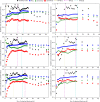Neuropsychological predictors of conversion from mild cognitive impairment to Alzheimer's disease: a feature selection ensemble combining stability and predictability
- PMID: 30567554
- PMCID: PMC6299964
- DOI: 10.1186/s12911-018-0710-y
Neuropsychological predictors of conversion from mild cognitive impairment to Alzheimer's disease: a feature selection ensemble combining stability and predictability
Abstract
Background: Predicting progression from Mild Cognitive Impairment (MCI) to Alzheimer's Disease (AD) is an utmost open issue in AD-related research. Neuropsychological assessment has proven to be useful in identifying MCI patients who are likely to convert to dementia. However, the large battery of neuropsychological tests (NPTs) performed in clinical practice and the limited number of training examples are challenge to machine learning when learning prognostic models. In this context, it is paramount to pursue approaches that effectively seek for reduced sets of relevant features. Subsets of NPTs from which prognostic models can be learnt should not only be good predictors, but also stable, promoting generalizable and explainable models.
Methods: We propose a feature selection (FS) ensemble combining stability and predictability to choose the most relevant NPTs for prognostic prediction in AD. First, we combine the outcome of multiple (filter and embedded) FS methods. Then, we use a wrapper-based approach optimizing both stability and predictability to compute the number of selected features. We use two large prospective studies (ADNI and the Portuguese Cognitive Complaints Cohort, CCC) to evaluate the approach and assess the predictive value of a large number of NPTs.
Results: The best subsets of features include approximately 30 and 20 (from the original 79 and 40) features, for ADNI and CCC data, respectively, yielding stability above 0.89 and 0.95, and AUC above 0.87 and 0.82. Most NPTs learnt using the proposed feature selection ensemble have been identified in the literature as strong predictors of conversion from MCI to AD.
Conclusions: The FS ensemble approach was able to 1) identify subsets of stable and relevant predictors from a consensus of multiple FS methods using baseline NPTs and 2) learn reliable prognostic models of conversion from MCI to AD using these subsets of features. The machine learning models learnt from these features outperformed the models trained without FS and achieved competitive results when compared to commonly used FS algorithms. Furthermore, the selected features are derived from a consensus of methods thus being more robust, while releasing users from choosing the most appropriate FS method to be used in their classification task.
Keywords: Alzheimer’s disease; Ensemble learning; Feature selection; Mild cognitive impairment; Neuropsychological data; Prognostic prediction; Time windows.
Conflict of interest statement
Ethics approval and consent to participate
The CCC study was conducted in accordance with the Declaration of Helsinki, and was approved by the local (Hospital de Santa Maria e Faculdade de Medicina da Universidade de Lisboa) ethics committee. The ADNI study was conducted according to the Good Clinical Practice guidelines, the Declaration of Helsinki, and US 21 CFR: Part 50 (Protection of Human Subjects) and Part 56 (Institutional Review Boards). The ADNI study was conducted in compliance with HIPAA regulations. Written informed consent to participate in the study was obtained from all (CCC and ADNI) participants and/or authorized representatives. Data access was de-identified on both studies.
Consent for publication
Not applicable.
Competing interests
All authors declare that they have no competing interests.
Publisher’s Note
Springer Nature remains neutral with regard to jurisdictional claims in published maps and institutional affiliations.
Figures



References
-
- Prince M, Wimo A, Guerchet M, Gemma-Claire A, Wu Y-T, Prina M. World Alzheimer report 2015: the global impact of dementia - an analysis of prevalence, incidence, cost and trends. London: Alzheimer’s Dis. Int; 2015.
-
- Alzheimer Association . Alzheimer’s Dement. 2016. 2016. 2016 Alzheimer’s Disease Facts and Figures; pp. 1–80.
-
- Prince M, Comas-Herrera A, Knapp M, Guerchet M, Karagiannidou M. Alzheimer’s dis. Int. 2016. World Alzheimer Report 2016: Improving healthcare for people living with dementia.
-
- Petersen RC, Smith GE, Waring SC, Ivnik RI, Tangalos EG, Kokmen E. Mild cognitive impairment. Clinical Characterization and Outcome Arch Neurol. 1999;56:303–308. - PubMed
Publication types
MeSH terms
Grants and funding
LinkOut - more resources
Full Text Sources
Medical

